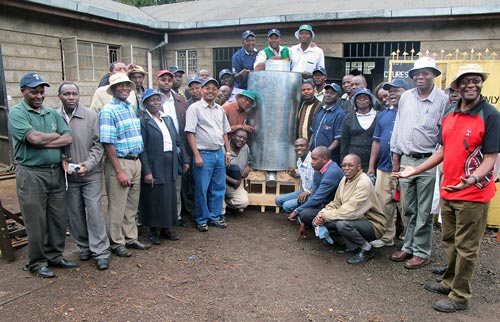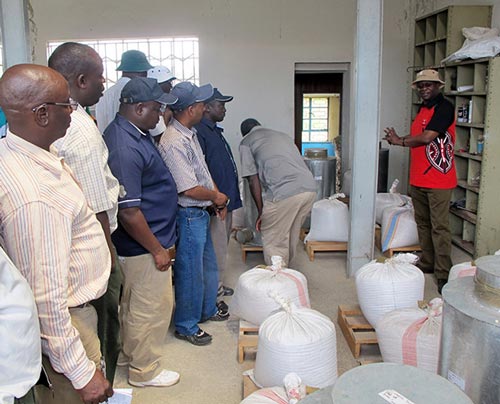By Wandera Ojanji

Officials from Malawi and Zambia learned about the benefits of effective grain storage for the livelihoods of smallholder farmers during a visit to Kenya from 7 to 12 October. Malawi and Zambia are target countries of CIMMYT’s Effective Grain Storage for Sustainable Livelihoods of African Farmers (EGSP) Phase II Project. EGSP-II (2012-2016) builds on the previous phase (2008-2011) to improve the food security and reduce the vulnerability of resource-poor farmers – particularly women – in eastern and southern Africa through the dissemination of effective grain storage technology. The project is funded by the Swiss Agency for Development and Cooperation (SDC) and will help smallholder farmers in Kenya, Malawi, Zambia and Zimbabwe acquire more than 16,000 metal silos, which reduce grain losses from storage pests.
The visiting delegation included officials from ministries of agriculture, the Chitedze Research Station in Malawi, the Zambia Agricultural Research Institute and silo artisans from the two EGSP countries. They were accompanied by implementing counterparts in Kenya from the Catholic Dioceses of Embu and Nakuru and the Kenya Agricultural Research Institute.
The tour started in Embu County in eastern Kenya with a visit to the homestead of Gladys Nthiga, a farmer who recently acquired two metals silos with a capacity of 450 kg each. She had not used the silos before but was excited to find technology to protect her harvests from maize weevils and the larger grain borer. “Despite treating my grains with pesticides, I was still losing about nearly half a ton of maize every year,” said Nthiga, whose annual maize harvest averages 1.8 tons. “If what I have been told about the technology is true, then my problems with these pests are over.” Peter Njiiru, the principal of Kierie Secondary School in Embu County, said he purchased a metal silo in June for maize storage and planned to add three more.
The delegation then visited Nakuru County. Grace Githui, the county liaison officer, noted that Nakuru is a primary maize-producing area and experiences high post-harvest losses due to smallholder farmers’ ineffective storage options. “We are very grateful to CIMMYT for introducing the metal silo technology in this area,” Githui said. “The silos’ effectiveness has been demonstrated against weevils and the larger grain borer, the two pests that are responsible for much of the county’s post-harvest losses. The silos provide enormous benefits to the farmers who have adopted them. We are urging widespread adoption and investing heavily to create awareness among farmers.” Maize is a major component of the diet in Kenyan schools.

Jane Obwocha, the deputy principal of Uhuru High School in Nakuru, noted the school avoids purchasing maize in bulk due to heavy losses during storage, a factor she attributed to poor storage facilities. “The metal silo is indeed a timely and critical intervention in maize storage as most schools, just like ours, lack effective storage facilities,” Obwocha said. The delegation also met with members of BOLESA, a group for women living with HIV/AIDS and former commercial sex workers under rehabilitation. The members, drawn from Boror, Lelechwet and Salgaa villages in Nakuru, are using a 900 kg-capacity metal silo acquired last year to store their maize. At Baraka Agricultural College, the delegation saw a new metal silo prototype that facilitates removing the grain stored.
The college has also started creating awareness about the technology and promotes it to farmers from Kenya and other parts of eastern Africa. The visiting delegates were impressed by the adoption of metal silos by farmers, grain dealers, vulnerable people, schools and colleges to protect their grain and avoid purchasing expensive storage chemicals. The visit also helped the delegates identify issues to address for successful project implementation.
 Capacity development
Capacity development 
